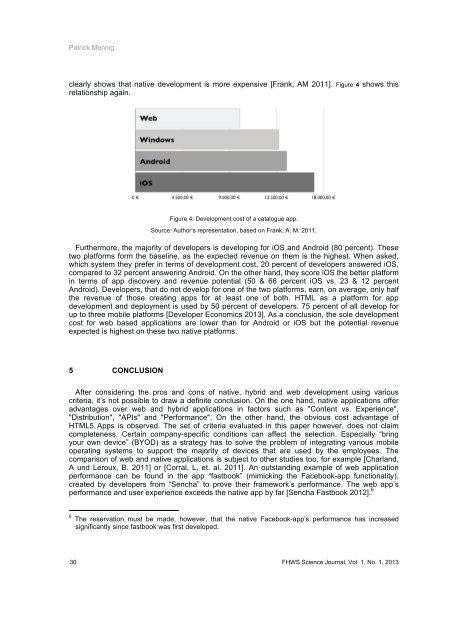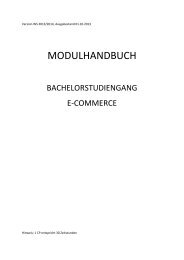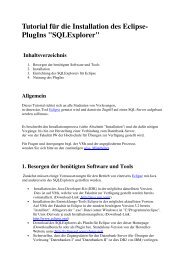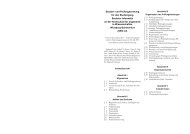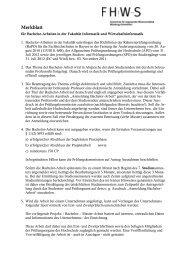FHWS Science Journal - Fakultät Informatik und Wirtschaftsinformatik
FHWS Science Journal - Fakultät Informatik und Wirtschaftsinformatik
FHWS Science Journal - Fakultät Informatik und Wirtschaftsinformatik
Create successful ePaper yourself
Turn your PDF publications into a flip-book with our unique Google optimized e-Paper software.
Patrick Mennig<br />
clearly shows that native development is more expensive [Frank, AM 2011]. Figure 4 shows this<br />
relationship again.<br />
Figure 4: Development cost of a catalogue app.<br />
Source: Author’s representation, based on Frank, A. M. 2011.<br />
Furthermore, the majority of developers is developing for iOS and Android (80 percent). These<br />
two platforms form the baseline, as the expected revenue on them is the highest. When asked,<br />
which system they prefer in terms of development cost, 20 percent of developers answered iOS,<br />
compared to 32 percent answering Android. On the other hand, they score iOS the better platform<br />
in terms of app discovery and revenue potential (50 & 66 percent iOS vs. 23 & 12 percent<br />
Android). Developers, that do not develop for one of the two platforms, earn, on average, only half<br />
the revenue of those creating apps for at least one of both. HTML as a platform for app<br />
development and deployment is used by 50 percent of developers. 75 percent of all develop for<br />
up to three mobile platforms [Developer Economics 2013]. As a conclusion, the sole development<br />
cost for web based applications are lower than for Android or iOS but the potential revenue<br />
expected is highest on these two native platforms.<br />
5 CONCLUSION<br />
After considering the pros and cons of native, hybrid and web development using various<br />
criteria, it’s not possible to draw a definite conclusion. On the one hand, native applications offer<br />
advantages over web and hybrid applications in factors such as "Content vs. Experience",<br />
"Distribution", "APIs" and "Performance". On the other hand, the obvious cost advantage of<br />
HTML5 Apps is observed. The set of criteria evaluated in this paper however, does not claim<br />
completeness. Certain company-specific conditions can affect the selection. Especially “bring<br />
your own device” (BYOD) as a strategy has to solve the problem of integrating various mobile<br />
operating systems to support the majority of devices that are used by the employees. The<br />
comparison of web and native applications is subject to other studies too, for example [Charland,<br />
A <strong>und</strong> Leroux, B. 2011] or [Corral, L. et. al. 2011]. An outstanding example of web application<br />
performance can be fo<strong>und</strong> in the app “fastbook” (mimicking the Facebook-app functionality),<br />
created by developers from “Sencha” to prove their framework’s performance. The web app’s<br />
performance and user experience exceeds the native app by far [Sencha Fastbook 2012]. 6<br />
6 The reservation must be made, however, that the native Facebook-app’s performance has increased<br />
significantly since fastbook was first developed.<br />
30 <strong>FHWS</strong> <strong>Science</strong> <strong>Journal</strong>, Vol. 1, No. 1, 2013


